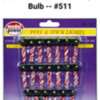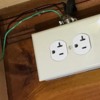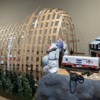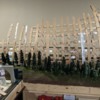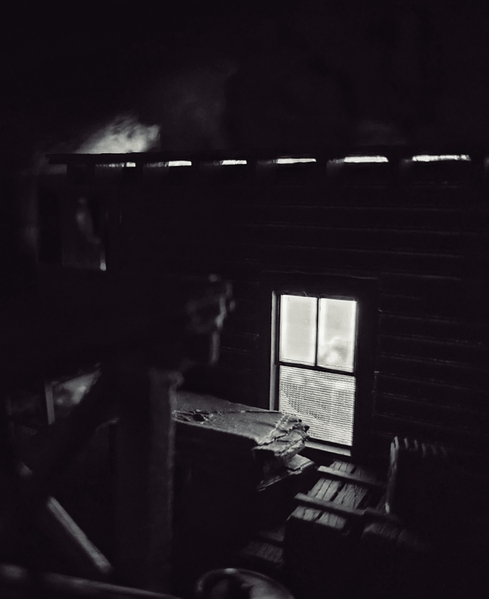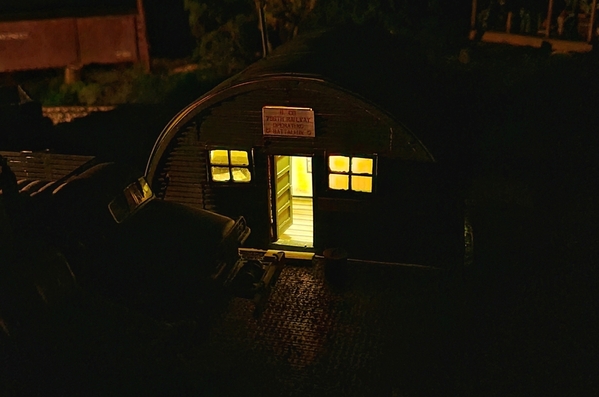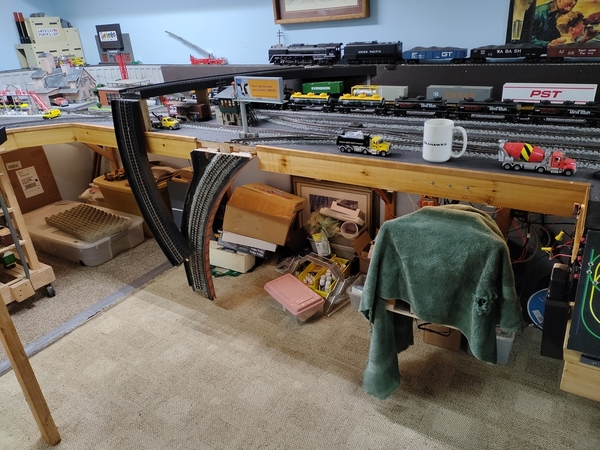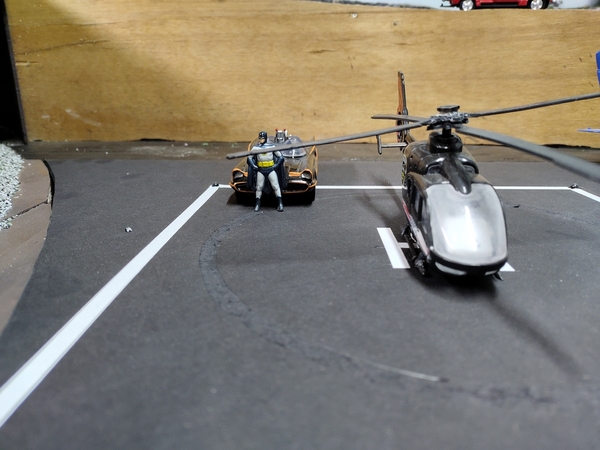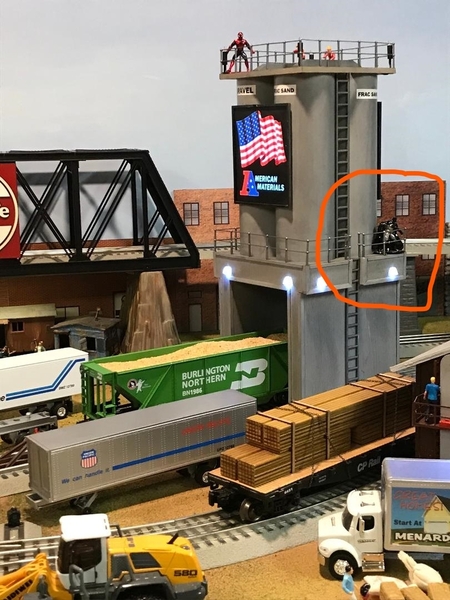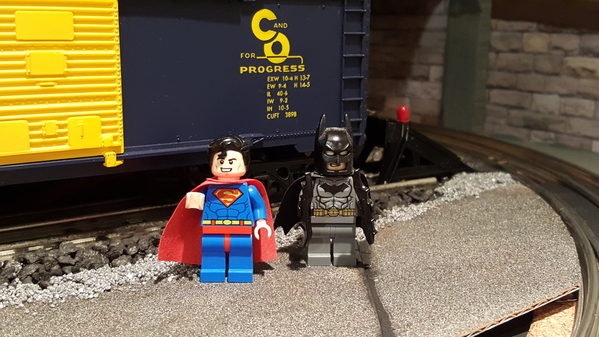Sorry to hear about the theft Chris; that’s disheartening. Glad you were nearby to stop the unwanted creek from forming on the floor of the layout. However, the concrete weathering looks superb.
@Dallas Joseph- the black piece is the LED assembly. I bought these from Model Power before I started making my own.
@Steamfan77- feel free to steal any ideas you want. No copyright infringement here.
@chris a- sorry to hear about the recent issues. The CAT's have become a hot item for thieves. I just saw an article about how fast they can remove them. Nice work on the freight depot.
@mike g.- the reverse loop is looking good.
@modeltrainsparts- not fancy, but swapping out lights to LED's is a good idea.
Nothing to report on my end. Like many of us, life does get in the way. I'm hoping to get started on another ERR upgrade soon.
Bob
Attachments
@RSJB18 posted:@Dallas Joseph- the black piece is the LED assembly. I bought these from Model Power before I started making my own.
Bob
Thanks Bob.
" before I started making my own " .......and what did you find to do that ? 🤔
From the looks of it , I'm going to have to enlarge my jun_ ..err inventory bin. ![]()
@Dallas Joseph posted:Thanks Bob.
" before I started making my own " .......and what did you find to do that ? 🤔
From the looks of it , I'm going to have to enlarge my jun_ ..err inventory bin.
I meant that I bought loose LED's and resistors and started building my own lights. No solution for the plastic housing but so far I have not needed to create one.
Attachments
I've been using my Lionel Legacy system for about 4-5 years now without having the base plugged into a grounded outlet. As many of you know, Legacy basically uses a home's ground system as an antenna for the system, but my house was built in the early '50's and, although the first and second floors have been upgraded during re-modeling to three-wire outlets, the basement where the layout is located never had grounded outlets and was never upgraded. I've been making adjustments to improve the signal over the years with a signal booster, ground plane wires and other remedies designed to improve the signal, but with about a 38' main line run on one side, I decide it needed to be improved once and for all.
So last weekend, I bit the bullet and decided to install a ground wire running from the ground bar in the main panel to the ungrounded outlet under the layout and bought a 100' roll of some 12 gauge solid green wire and started. I ran the wire around the furnace room where the main panel is located and then up and through the suspended ceiling panels in the main part of the basement and then through the main beam and into the train room and over more ceiling panels and then down the wall and through the layout to the old box (which was surface mounted on the wall under the layout).
I bought a new surface mount box, grounded outlet and clamp and removed the old box and installed the new hardware and ran the ground wire next to the old conduit and through the clamp and into the box and screwed to the outlet.
Not very glamorous work, but at least I know the system is basically bulletproof now.
Pic of main panel tie in and new outlet.
Attachments
@Richie C. posted:I've been using my Lionel Legacy system for about 4-5 years now without having the base plugged into a grounded outlet. As many of you know, Legacy basically uses a home's ground system as an antenna for the system, but my house was built in the early '50's and, although the first and second floors have been upgraded during re-modeling to three-wire outlets, the basement where the layout is located never had grounded outlets and was never upgraded. I've been making adjustments to improve the signal over the years with a signal booster, ground plane wires and other remedies designed to improve the signal, but with about a 38' main line run on one side, I decide it needed to be improved once and for all.
So last weekend, I bit the bullet and decided to install a ground wire running from the ground bar in the main panel to the ungrounded outlet under the layout and bought a 100' roll of some 12 gauge solid green wire and started. I ran the wire around the furnace room where the main panel is located and then up and through the suspended ceiling panels in the main part of the basement and then through the main beam and into the train room and over more ceiling panels and then down the wall and through the layout to the old box (which was surface mounted on the wall under the layout).
I bought a new surface mount box, grounded outlet and clamp and removed the old box and installed the new hardware and ran the ground wire next to the old conduit and through the clamp and into the box and screwed to the outlet.
Not very glamorous work, but at least I know the system is basically bulletproof now.
Pic of main panel tie in and new outlet.
Creative but I cant tell you how many parts of the national electrical code you just violated. Sorry to say that you are putting your homeowners insurance at risk in case of fire too.
Stray grounds can cause bigger issues for your electric service as well. I would recommend removing the wire asap. Get a coil of 12/2 NMb wire and run a new circuit. Seems like you found the path already.
Bob
Holy crap, better hope your town building inspector or insurance agent doesnt frequent the OGR forum. I second Bob's recommendations. Do not forget that ground you installed is not just for TMCC signal improvements but is now your outlet's 3rd prong - which has an entirely different purpose from running trains!
Ritchie….please pay attention to this guidance from RSJB and Farmall. I hate to jump on board with the Debbie Downer pile on after all of your hard work, but it is with all of the best collective intentions and your best interests at heart.
Yes not to push the panic button, or pick on you particularly, but consider this info (assembled from various sources):
The 3rd prong can be thought of as an emergency path for electricity to travel through if a short circuit or other fault develops inside the electrical device. Inside all appliances that have plugs are wires and other electrical components that can potentially break off and can create a new electrical path. Water intrusion can also create such a path. These can be carrying household current which contact and charge the outer case or metal connectors of an electrical appliance. If the device case is not grounded, it is highly likely that the next person who touches the device will receive a potentially lethal electric shock. If a grounding circuit is present and intact, the electricity flows along the ground and trips the breaker or blows a fuse, which halts the power supply. Why don’t all appliances have 3 wire plugs? Well some devices can have internal shielding which would prevent current to case contact. Or the case may be non conductive. Thankfully you used an insulated wire. However, consider one layer of insulation vs insulation AND cable jacket. Securing or pulling a wire with a single layer of insulation could result in damaging that insulation. Should that wire come into contact with water pipes, as an example, you just electrified your home piping system (if there were a concurrent fault with whatever is connected to the new outlet).
Oh, and please hire a LICENSED ELECTRICIAN when working in that box.
Was repairing a section on the back of my layout (photos on the TPRR link) and in the meantime, test ran an engine across the repaired track to check for engine movement. Worked great for 2 loops and then my Z4000 decided not to reset to zero. Got the fault light and now its repair time for the 4000. At least I hope that is the problem. I really think that the handle link mechanism is a less than good design, really sloppy operation, even with the trim adjustment screw. Good thing I have a couple of Z1000 bricks to switch in to run things with the TIU. Kind of making me want to go back to HO - no that is not going to happen - what am I thinking.
With the demolition I got a couple of ideas on re-configuring the town. I have never really liked the placement of a couple of the buildings. This new idea seems workable given the space. More on that later. Just a hint - I figured out where to place the lone twin pine (as yet un-grown) which will make sense. to me at least ![]()
In response to the discussion to Richie's ground, I grew up in a house my great-grandfather had built in 1888. It had a 150 Amp fusebox and some ungrounded circuits. Dad never wanted to spend money he didn't have to, but once he and Mum went into a personal care home, I knew I needed to replace the fuse box with a breaker box for any insurance company to approve. I hired a licensed electrician, and did some scouting around to find potential problems to ask him about. I knew there was some knob and tube wiring abandoned in place on the log joists and rough hewn framing in the cellar. Imagine my surprise when I discovered one circuit was still in service. It fed two bulbs and two outlets in the sunporch!! The cellar lighting circuit consisting of 2 porcelain overhead light sockets with pull string bulbs with 2-prong outlets. I had the electrician replace them for sure as well and a few other runs.
All this to say; my layout during my teenage years was in that cellar with the dim lights and 2-prong outlets. It's a good thing I didn't need a grounded circuit then, like I do now for my layout.
BTW, sadly we sold the house 2 years ago after 131 years in the family.
Mark…..it’s really hard to let go of family legacy real estate. I appreciate that. Thanks for sharing. Best, W
Yep. We all survived somehow. 2 prong plugs, no bike helmets, steel dashboards and no seatbelts and trains without computers!
Actually accomplished what I set out to do today (rare !). Almost completed the installation and wiring of the lighting of the freight depot today. I ended up installing a mini 2 prong plug between the building sections, to make removal easier as the single structure is actually built in 2 separate sections due to it's length.
Only have to hook up the feed wires beneath the table at this point, but didn't feel like getting under there this evening. Haven't used any of these LED warm white 300 LED light strips before this project, but they are pretty slick for providing even lighting. With the variable DC Buck Converters I purchased, I have plenty of control over the brightness.
I plan to use these same in the Left and Right wings of Union Station Kit-bash, as well as go back and re-lamp the 2 stall 32 inch long, IHC Engine house in the Steam Service Facility.
Attachments
Work continued this evening. The mountain is continuing to grow and is starting to curve inward at about the right height. So far, I am starting to struggle to reach over with my short height. Progress of curving it over will probably halt until I creat a hatch behind it and build a shelf for all the rolling stock stored in the space. In the meantime, I will probably make a few further additional adjustments and then begin plastering.


Attachments
@chris a posted:Actually accomplished what I set out to do today (rare !). Almost completed the installation and wiring of the lighting of the freight depot today. I ended up installing a mini 2 prong plug between the building sections, to make removal easier as the single structure is actually built in 2 separate sections due to it's length.
Only have to hook up the feed wires beneath the table at this point, but didn't feel like getting under there this evening. Haven't used any of these LED warm white 300 LED light strips before this project, but they are pretty slick for providing even lighting. With the variable DC Buck Converters I purchased, I have plenty of control over the brightness.
I plan to use these same in the Left and Right wings of Union Station Kit-bash, as well as go back and re-lamp the 2 stall 32 inch long, IHC Engine house in the Steam Service Facility.
Chris, my hats off to you for setting a goal and accomplishing the task! More than I can say about my layout after I expanded it 8 inches on the front and right side. After I installed the new siding I need to extend the road and RR crossing to the siding. The problem is the RR crossing is on a curve. I've been trying to figure out the best way to put the road in-between the rails, then I saw your post about using 1/8th in thick cork RR bedding! Man that woke me up! I went right out to the local model RR store and picked some up. I just starting cutting the cork today, hopefully I can find the time tomorrow to do some more. Thanks for your post on the cork, much easier than what I was planning!!! It should look perfect for asphalt once painted.

Your warehouse with those LED's should look fantastic when completed! I can't wait to see it a lit up.
Attachments
Work continued this evening. The mountain is continuing to grow and is starting to curve inward at about the right height. So far, I am starting to struggle to reach over with my short height. Progress of curving it over will probably halt until I creat a hatch behind it and build a shelf for all the rolling stock stored in the space. In the meantime, I will probably make a few further additional adjustments and then begin plastering.
Trainmaster04,
What is that animal climbing up on the right of the structure in the 2nd pic?
John,
That's funny!
Dave
@Trainmaster04 posted:Work continued this evening. The mountain is continuing to grow and is starting to curve inward at about the right height. So far, I am starting to struggle to reach over with my short height. Progress of curving it over will probably halt until I creat a hatch behind it and build a shelf for all the rolling stock stored in the space. In the meantime, I will probably make a few further additional adjustments and then begin plastering.
I can't think of any other way to say this, but it looks like a blimp hangar under construction, to me. Is it really going to represent a rock formation that shape?
I appreciate everyone's concern for my safety, but there's nothing inherently unsafe about running a separate properly insulated ground wire to join a two-wire conduit in a proper outlet. Yes, it would have been better to simply replace the existing conduit with new three-wire conduit, but that would have required tearing half the basement out. In reality, the only difference is that the ground wire runs outside the existing conduit and, as such, is not covered by the extra insulation that provides; however, that does not mean that it is dangerous.
The fact that it may not comply with existing NE code regulations does not, again, translate into being dangerous; only that there may be a better way of doing it.
This project was reviewed by both a licensed electrician and a professional electrical engineer before starting and, although they both recommended that the entire conduit should be replaced in accordance with code, neither felt that there was any inherent danger in doing it this way (and there's not).
Again, thanks for everyone's comments and concerns.
@Richie C. posted:This project was reviewed by both a licensed electrician and a professional electrical engineer before starting and, although they both recommended that the entire conduit should be replaced in accordance with code, neither felt that there was any inherent danger in doing it this way (and there's not).
I know alot of professional electrical engineers who dont know the NEC. Ask any licensed electrician...LOL. Seriously tho, they BOTH recommended it should be per code but there is no danger...okaaay. Pretty sure the code was developed to preclude dangerous situations! I am curious if they looked at it in person or conceptually. I can agree there is no danger now if the wire insulation is intact, it is not on any other metal structure in the house, and there is no fault actually occurring. From your photos i can point out the minimum bend radius on the ground wire at the outlet is probably not to code. Hopefully the remainder of your route is safe. Ultimately it is your house and will probably be fine for as long as you live there. Hopefully the next owner is as lucky.
Hmm...for some reason my reply ended up in your quote.
Hi guys I hope your all doing well!
@chris a First off sorry to hear about the robbery! Kinda why I wasn't here for about 2 weeks. I am glad you cought the water tank before you inherited a in ground pool. Your road looks outstanding, and I bet you had fun cutting and fitting the timbers for the RR crossing! Your lighting install looks like you hired a professional electrician to do the work! Very nice work!
@Richie C. I am sorry your system needs a ground plane to make it work better. I am with the rest of the guys and thing you should have just run a whole new circuit, but then again it is your house and your layout. I really hope it has made the improvements you were looking for!
@ScoutingDad Jeff I am glad you got the dip fixed and things seem to run fine. I am so sorry that your Z4000 died,but am glad you have backups to keep you going! I can't wait to see our re-configuration; I am sure you have something special in mind!
@Trainmaster04 The mountain is going to be an outstanding addition to your layout! Looking good and keep up the great work!
@p51 Lee, the lighting looks perfect!
Well guys, yesterday I went out and moved the switches for the construction crane right above my Z4000. At first what I thought was going to be an easy project turned out to be an all-day event! LOL First I had to install new facia to have something to mount the switches to then I had to rerun the wire to the carne. Everything worked fine when I took it apart, but when I got to the other end and hooked up the switch's nothing worked, after checking the wire I found that there was a break somewhere in the new wire I was using. Pulled it all out and ran new wire and it all works great now.
This morning I went out and put a coat of polyurethane on it and when that dries, I will put labels for each switch. Here is what it looks like now. I know it's hard to see the switches, but I didn't want to use large switches.
While I was working on that low and behold Batman showed up to use the Bat copter! LOL
I was going to work in the yard, but thunderstorms are in the area, so I think I will just go back out and clean up under the layout. I probably will find more stuff to sell that I don't think I will be using on the layout.
I hope you all have a great day and find time to have fun with your layouts and trains!
Attachments
@mike g. posted:
Holy Gotham layout!
There are times I do wish I wasn't so against whimsy on my layout (which is ironic cnsidering I have a great sense of humor, used to be a stand up comedian and have done cartoons for various publications from my youth to recent years) as well as not modelling the WW2 era, as there are times I see stuff like this and think, "Man, that'd be so cool to have the Batmobile (or the Back to the Future Delorean or a Dr Who TARDIS) sitting behind a building on the layout..."
@p51 posted:Holy Gotham layout!
There are times I do wish I wasn't so against whimsy on my layout (which is ironic cnsidering I have a great sense of humor, used to be a stand up comedian and have done cartoons for various publications from my youth to recent years) as well as not modelling the WW2 era, as there are times I see stuff like this and think, "Man, that'd be so cool to have the Batmobile (or the Back to the Future Delorean or a Dr Who TARDIS) sitting behind a building on the layout..."
LOL Lee, just for fun I think you could get away with either the Delorean or the Tardis!
Attachments
@p51: I agree with Mike g...you could put a single Delorean or a TARDIS on the layout and not give up much. I have seen some folks do this deliberately to entertain their young visitors by challenging them to a "can you find the X" type game when they visit the layout.
Don
@Richie C. posted:
@mike g. posted:Hi guys I hope your all doing well!
While I was working on that low and behold Batman showed up to use the Bat copter! LOL
I was going to work in the yard, but thunderstorms are in the area, so I think I will just go back out and clean up under the layout. I probably will find more stuff to sell that I don't think I will be using on the layout.
I hope you all have a great day and find time to have fun with your layouts and trains!
Did someone say Where's Batman?
Attachments
@Richie C. posted:I appreciate everyone's concern for my safety, but there's nothing inherently unsafe about running a separate properly insulated ground wire to join a two-wire conduit in a proper outlet. Yes, it would have been better to simply replace the existing conduit with new three-wire conduit, but that would have required tearing half the basement out. In reality, the only difference is that the ground wire runs outside the existing conduit and, as such, is not covered by the extra insulation that provides; however, that does not mean that it is dangerous.
The fact that it may not comply with existing NE code regulations does not, again, translate into being dangerous; only that there may be a better way of doing it.
This project was reviewed by both a licensed electrician and a professional electrical engineer before starting and, although they both recommended that the entire conduit should be replaced in accordance with code, neither felt that there was any inherent danger in doing it this way (and there's not).
Again, thanks for everyone's comments and concerns.
Richie- Since I started the conversation, I will make one additional comment and leave it at that.
In my professional opinion as a licensed master electrician with over 30 years in the industry, I completely disagree with the statements made by those who you consulted.
That being said, as the old saying goes around here.....your railroad, your rules.
Bob
@mike g. posted:LOL Lee, just for fun I think you could get away with either the Delorean or the Tardis!
I built a PECO model of the TARDIS, I'm as a big of an old-school Dr Who fan as you're likely to find.
I even wired the flashing beacon, then plugged that into the layout wiring for a few minutes while I got some poor cell shots of the thing.
I also once took a model of the 'Aliens' Marine APC that was darned close to O scale and got some shots of it at the grade crossing in the same spot for sci-fi forum.
But that's as close as you're going to get. While I don't begrudge anyone else for whimsy on their own layouts, I have a zero-tolerance policy for it on my own layout. I've just seen whimsy being so prevalent (and often very poorly applied) within the hobby, I refuse to take part.
Again, it's ironic given my own background. Knock yourselves out, but it ain't for me.
Attachments
@RSJB18 posted:Richie- Since I started the conversation, I will make one additional comment and leave it at that.
In my professional opinion as a licensed master electrician with over 30 years in the industry, I completely disagree with the statements made by those who you consulted.
That being said, as the old saying goes around here.....your railroad, your rules.
Bob
I appreciate your comments and expertise, but you can't just leave it like that without being more specific.
1. Tell me why running a separate insulated ground wire and two wire conduit from a main panel/ground bar to a code compliant outlet box is any more dangerous than just running three wire conduit from the main panel to the same box (other than the obvious that the ground wire is not contained within the conduit and does not have the extra insulation of the conduit), which to me is fairly inconsequential.
Added: BTW, I used high quality, fully insulated, code compliant 12 ga solid copper wire purchased from a local electrical supply store for the ground wire.
2. Also, please explain what could go potentially go wrong by my install and the likelihood that something like that would happen.
Thanks
With temps hitting 60 degrees here in Boston on March 2, (We still have snow on the ground !!), I decided to take out the airbrush, mix up some dull coat I recently purchased and dull coat two BAR boxcars that I had weathered with Pan Pastels. Finally found a local hobby shop that stocked Testors Dull Coat that I could dilute with Lacquer Thinner and apply with the airbrush, but I really didn't want to spray lacquer base inside the basement.
That went so well I took out a bunch of detail parts and primed them so I could final paint and weather them. 55 Gallon Drums, Wood pallets, Wood barrels, tools, and some 3D printed Machine shop tools and acetylene oxygen welding tanks etc. Been wanting to start painting and weathering these detail parts, but not without getting a good base coat of primer on them first. Hooking up the lights will have to wait.
@Richie C. posted:I appreciate your comments and expertise, but you can't just leave it like that without being more specific.
1. Tell me why running a separate insulated ground wire and two wire conduit from a main panel/ground bar to a code compliant outlet box is any more dangerous than just running three wire conduit from the main panel to the same box (other than the obvious that the ground wire is not contained within the conduit and does not have the extra insulation of the conduit), which to me is fairly inconsequential.
Added: BTW, I used high quality, fully insulated, code compliant 12 ga solid copper wire purchased from a local electrical supply store for the ground wire.
2. Also, please explain what could go potentially go wrong by my install and the likelihood that something like that would happen.
Thanks
I believe i provided all that you ask in one of my posts above. Additionally, both your electrician and prof engineer said you should rewire it to code. The code was developed over decades as a result of documentation of electrical hazards (fire, shock, etc) due to dangerous designs. Hence, if they think it should be to code, they inherently think it is dangerous. But as i and probably they said, it isnt dangerous just sitting there. It COULD BE dangerous when it performs its intended function which is to reroute 120VAC to ground in event an appliance fails internally. If that path is interrupted by poor wiring practices you might be sending 120VAC to something else - like your kitchen faucet for example. As for likelihood, i analyze the likelihood of short circuits in nuclear power plants. After years of testing it has been determined that just about any short you could expect can happen albeit once in 100,000 years - but that doesnt mean we dont design it to prevent it from happening. You seem determined to disagree with those providing you sound advice and that is your prerogative. I wonder tho, do you or your children or grandchildren use a seat belt? Do you look both ways before crossing a street? Do you wear safety glasses with power equipment? Do you have a car with airbags? Do you have smoke and CO detectors in your house? Is your money in an insured bank? Do you throw out food thats been in the fridge too long? All of these things prevent injury to you in the unlikely (yet possible) event something bad did happen...why not in the case of your wiring?
Just like you Chris, I got the painting urge - only here in lovely Ooltewah, Tennessee, the temp hit a glorious 75 under mostly sunny skies. Got my #76 bell ringer well painted, with few errors. One more coat on some pieces should do it! Now to wait 2 days....
George
Two weeks after a knee replacement, working on the layout is not as easy and little exciting has been done BUT, what an opportunity to update our computer records, create labels for wiring, terminal blocks, and relays, and to go thru and transcribe or delete the numerous “important” yellow pad notes.
The trash can is half full. I called Rich yesterday and told him that we can finally get the labels up to date; they are printed and need to be attached. Kinda like show and tell where I show and Rich gets under the layout which Paula won’t let me try yet.
Today updating the Railroad Tracks program is on the agenda. We need to update the engine service area and add the transfer table and buildings that are now in place. Then we can update the projected track plan. It looks like a trip to Atlanta, Indiana (Mr Muffin) to look at his layout/use of bridges and to Mt Ephraim, NJ to check out scenery tactics with Harry Hieke will be in order in late Spring. Rich has a twin Duchess and is interested in going.
@Farmall-Joe posted:I believe i provided all that you ask in one of my posts above. Additionally, both your electrician and prof engineer said you should rewire it to code. The code was developed over decades as a result of documentation of electrical hazards (fire, shock, etc) due to dangerous designs. Hence, if they think it should be to code, they inherently think it is dangerous. But as i and probably they said, it isnt dangerous just sitting there. It COULD BE dangerous when it performs its intended function which is to reroute 120VAC to ground in event an appliance fails internally. If that path is interrupted by poor wiring practices you might be sending 120VAC to something else - like your kitchen faucet for example. As for likelihood, i analyze the likelihood of short circuits in nuclear power plants. After years of testing it has been determined that just about any short you could expect can happen albeit once in 100,000 years - but that doesnt mean we dont design it to prevent it from happening. You seem determined to disagree with those providing you sound advice and that is your prerogative. I wonder tho, do you or your children or grandchildren use a seat belt? Do you look both ways before crossing a street? Do you wear safety glasses with power equipment? Do you have a car with airbags? Do you have smoke and CO detectors in your house? Is your money in an insured bank? Do you throw out food thats been in the fridge too long? All of these things prevent injury to you in the unlikely (yet possible) event something bad did happen...why not in the case of your wiring?
Because, unlike the examples in your post, none of you amateur electricians on the Forum (excluding Bob) can pinpoint why my technique is more inherently more dangerous than running a typical three-wire conduit - that's why. The fact that my ground wire has less insulation than if it were inside a conduit or that my bend might exceed the minimum radius by a degree or two are a joke and just saying something is not up to code is a cop out.
Codes are also designed to establish safe practices for new products and new techniques, but that does not mean that old ones are dangerous. Code now requires grounded systems in all new construction. Does that mean that all houses with two wire systems should be immediately condemned and torn down - of course not.
Did you ever jaywalk ? Did you ever pick up a piece of food that fell on the floor and then eat it ? Did you ever go swimming less than hour after you ate ? Did you ever exceed the speed limit in your car ? Did you die from any of these ?
With all the other things of greater importance in this thread, this will be my last post on this subject.
Again, thanks to all for your concerns.
Richie C: thanks for committing to make it your last post. I am worn out reading the debate and the venting.
@Richie C. posted:Because, unlike the examples in your post, none of you amateur electricians on the Forum (excluding Bob) can pinpoint why my technique is more inherently more dangerous than running a typical three-wire conduit - that's why. The fact that my ground wire has less insulation than if it were inside a conduit or that my bend might exceed the minimum radius by a degree or two are a joke and just saying something is not up to code is a cop out.
Codes are also designed to establish safe practices for new products and new techniques, but that does not mean that old ones are dangerous. Code now requires grounded systems in all new construction. Does that mean that all houses with two wire systems should be immediately condemned and torn down - of course not.
Did you ever jaywalk ? Did you ever pick up a piece of food that fell on the floor and then eat it ? Did you ever go swimming less than hour after you ate ? Did you ever exceed the speed limit in your car ? Did you die from any of these ?
With all the other things of greater importance in this thread, this will be my last post on this subject.
Again, thanks to all for your concerns.
Well we've all been respectful with our concerns and laid out the reasons why. There is no joke and no one is coping out. It is not our place to research the entire code book for you. For anyone else who would like to heed the warning here is the primary code being probably violated...i say probably because i have not researched the entire electric code here. It is up to the homeowner to abide by the laws and provide safety for his or her family, future home owners or anyone potentially working in the house. I reiterate that RichieC's licensed electrician felt he should rewire to be in compliance with the code.
TABLE E3701.2 ALLOWABLE WIRING METHODS
Armored cableAC
Electrical metallic tubingEMT
Electrical nonmetallic tubingENT
Flexible metal conduitFMC
Intermediate metal conduitIMC
Liquidtight flexible conduitLFC
Metal-clad cableMC
Nonmetallic sheathed cableNM
Rigid nonmetallic conduitRNC
Rigid metallic conduitRMC
Service entrance cableSE
Surface racewaysSR
Underground feeder cableUF
Underground service cableUSE
E3701.3 Circuit conductors.
All conductors of a circuit, including equipment grounding conductors, shall be contained in the same raceway, trench, cable or cord.
And for the record, i've been an electrical engineer in the nuclear power industry for 20 years...not an "amateur".
You can lead a horse to water...





